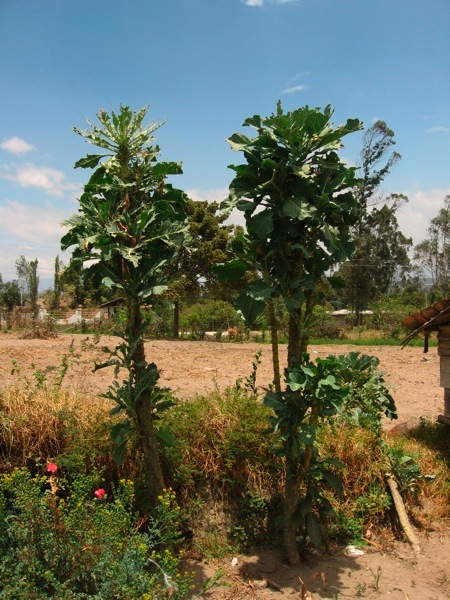Where did that come from, I asked myself, as we looked around the home garden of an agrotourist lodge near Cotacachi in Ecuador. No, not the wonderful neotropical fruits, or the fiery Brugmannsia, or the tree they called guava that looked to me like a carob; certainly a legume of some sort. 1 Not any of the exotica that were at home here, but this thing, a brassica looking for all the world like a small tree.

To me it looked like one of the perennial kales, or even the Jersey Walking Stick Cabbage that I’ve grown in the UK and seen in Basque country and parts of Portugal. On the other side of the path was a red-leaved variety that had a much more dissected leaf, a little like Red Russian kale but again growing like a tree.
Fortunately the lady of the lodge, Dona Digna, who has every reason to be proud of the accomplishments of her community, was there with us, and even more fortunately I had the services of an expert translator. 2 I asked how they used it, and was told that they picked individual leaves as needed, and that now it was not good at all, much too tough. OK, well then how do you get tender leaves? In the spring, we make new plants. How?

At which Digna snapped off a branch of the red kale and said that you just plant a stem in the ground. So it never has flowers? No, never.
So it really is a perennial brassica, not one of the walking stick types, which do flower and set seed. But that’s as far as I could go in my investigation. I have no idea how long the local people have been growing it, where they first got it from, or what they think of it. But it was fun to see something truly exotic in Ecuador. And maybe it could add a datapoint to a study that revealed a high degree of duplication among perennial kale accessions.
At last a kale which can be picked at a civilised height! I wonder, however, whether the combination of low chill and fairly constant photoperiod might be inhibiting flowering in long day adapted European material. I think there’s a gene called CONSTANS which is responsible for initiating flowering in Arabidopsis during long days. It might be the same in Brassica. It would be easy enough to find out and I bet there’s a whole load of perennial veg fanatics out there who’d be willing to beat a path to Dona Digna’s door.
If I’d thought to I would have brought back the sprig she tore off, but I’m not sure it would have survived the journey. My case is crammed. But there was space for a piece of toilet paper hastily smeared with Solanum quitoense seeds.
Must have been an Inga species (called guaba in Ecuador, not to be confused with guava, the English name for Psidium guajava, or guayaba (its Spanish equivalent). In English the species is referred to as pacay or, more attractive, ice-cream bean (I hope you had a chance to try it…)
This is a truly Neotropical genus with lots of different species from the Amazon up to the Andes (a search in the New World Fruits Database results in 46 species). Further reading in Lost crops of the Andes and, if you want to know everything on Inga, in the ICRAF/Kew publication The Genus Inga: Utilization (not free).
Based on your comparison with carob, combined with the Andean presence, I would guess the species you observed was Inga feuilleei.
Ice cream beans taste good and have apparently been used successfully as an alley cropping alternative to slash and burn by Cornish farmer/ tropical agro-ecologist Mike Hands. I think he usually uses Inga edulis.
Thanks Xavier and Owen. Indeed, Marleni confirmed that it was probably a species of Inga, though not which one. My comparison with carob was very superficial. The pods weren’t smooth at all, but they were carob sized. I was told that one eats the powder surrounding the bean. Is that right?
What is eaten is the tissue surrounding the seed (the aril, as in lychee). It is more a sponge-like structure than a powder. Tastes sweet and refreshing. Some species/accessions have very limited quantities of edible parts (would be a nice trait for characterization).
A dozen years ago I saw perennial kale in Cuyo-Cuyo in southern Peru. It was not the curly-leaved purple kind in the second image here. It’s nickname was “Flag of Cuyo-Cuyo” because it was so common in the village there. I didn’t ask enough about it, and it didn’t occur to me that it might never flower. At the time I assumed it was just the moist and frost free climate of the mid-elevation eastern Andean slopes that allowed it to persist. Thanks for bringing attention to this plant.
Any way to get a cutting of this wonderful plant?